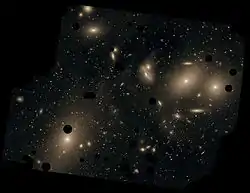The Bautz–Morgan classification was developed in 1970 by Laura P. Bautz and William Wilson Morgan to categorize galaxy clusters based on their morphology.[1] It defines three main types: I, II, and III. Intermediate types (I-II, II-III) are also allowed. A type IV was initially proposed, but later redacted before the final paper was published.[2]
Classification
- A type I cluster is dominated by a bright, large, supermassive cD galaxy; for example Abell 2029 and Abell 2199.
- A type II cluster contains elliptical galaxies whose brightness relative to the cluster is intermediate to that of type I and type III. The Coma Cluster is an example of a type II.
- A type III cluster has no remarkable members, such as the Virgo Cluster. Type III has two subdivisions, type IIIE and type IIIS
- Type IIIE clusters do not contain many giant spirals
- Type IIIS clusters contain many giant spirals
- The deprecated type IV was for clusters whose brightest members were predominantly spirals.[2]
Examples
| Example | Type | Notes | |
|---|---|---|---|
 |
Abell 2199 | Type I | |
 |
Abell S740 | Type I-II | |
.jpg.webp) |
Coma Cluster | Type II | |
 |
Abell 1689 | Type II-III | |
 |
Virgo Cluster | Type III | |
| Type IIIS | |||
| Type IIIE | |||
See also
References
- ↑ Bautz, L. P.; Morgan, W. W. (December 1970). "On the Classification of the Forms of Clusters of Galaxies" (PDF). Astrophysical Journal. 162: L149. Bibcode:1970ApJ...162L.149B. doi:10.1086/180643. A&AA ID. AAA004.160.015. Retrieved March 10, 2012.
- 1 2 Bautz, Laura P.; Morgan, W. W. (September 1970). "Preliminary Classification of Clusters of Galaxies" (PDF). Bulletin of the American Astronomical Society. 2: 294. Bibcode:1970BAAS....2R.294B. A&AA ID. AAA004.160.006. Retrieved March 10, 2012.
This article is issued from Wikipedia. The text is licensed under Creative Commons - Attribution - Sharealike. Additional terms may apply for the media files.